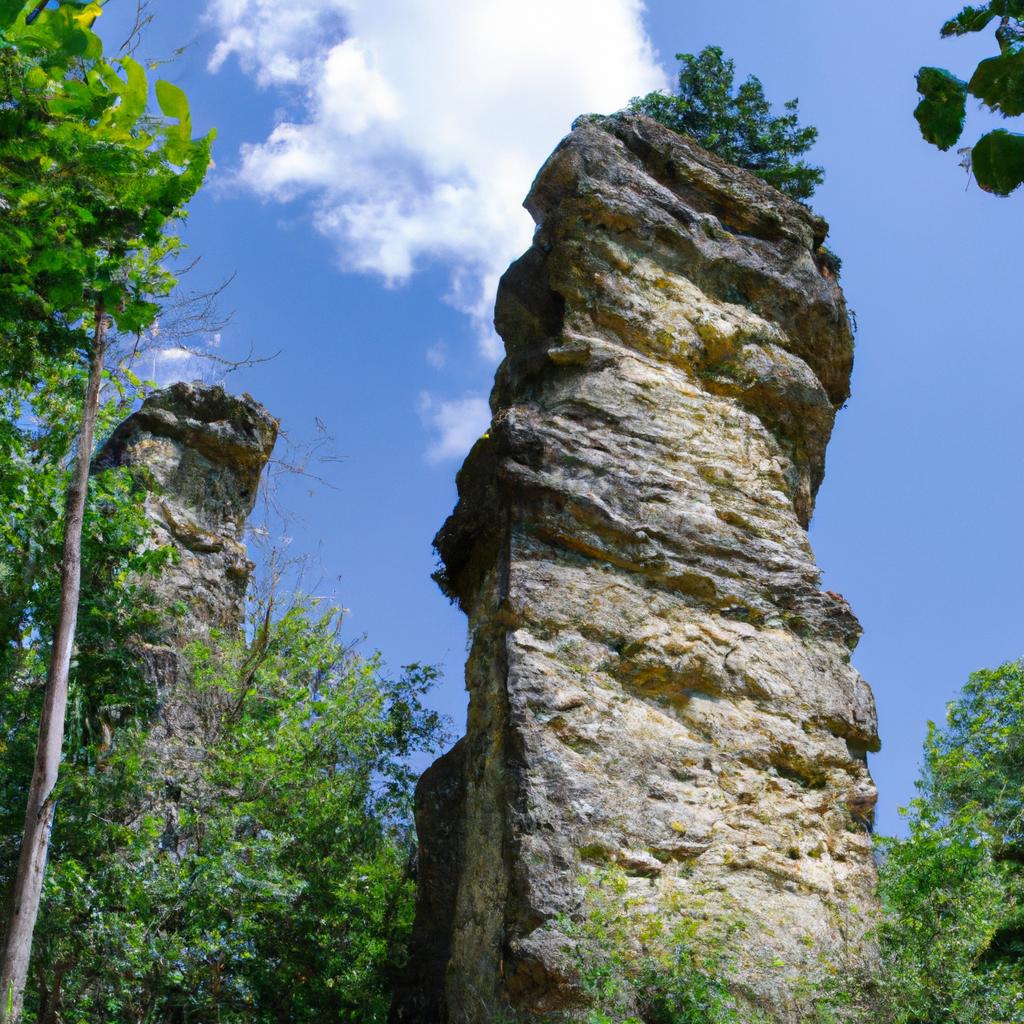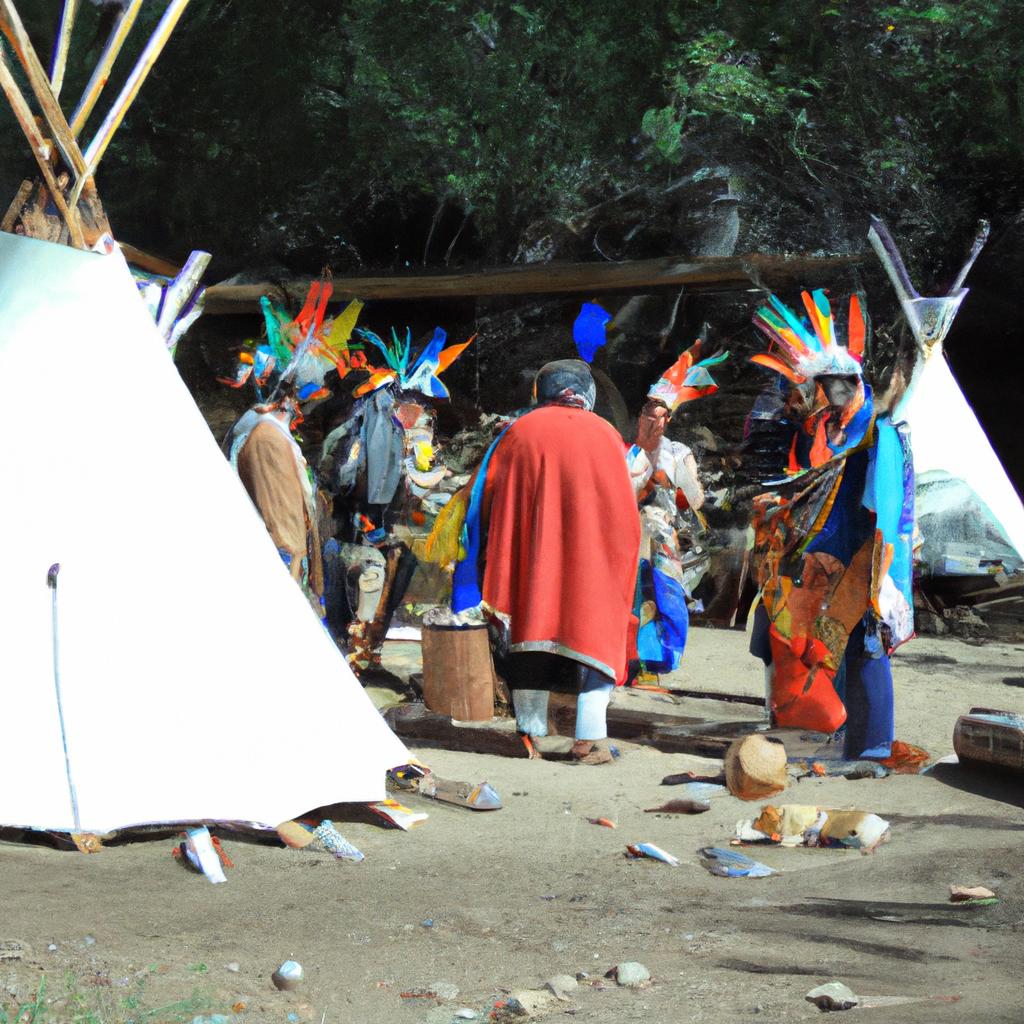Devils Tower, located in northeastern Wyoming, USA, is a unique and mysterious geological formation that has intrigued people for centuries. The name itself sparks curiosity and has given rise to countless legends and myths. In this article, we will delve into the origins of the name Devils Tower and explore its significance.
Unveiling the Geological and Historical Background

A majestic view of the towering natural formation known as Devils Tower.
At 867 feet tall, Devils Tower stands as a prominent geological feature in the Black Hills region of northeastern Wyoming. This unique formation is composed of igneous rock and was formed millions of years ago through volcanic activity. As the magma rose to the surface, it solidified, resulting in the rock structure we observe today. Over time, erosion gradually eroded the softer rock layers surrounding the tower, exposing it to the elements and giving it its distinctive appearance.
Significance to Native American Tribes

A portrait of a Native American elder from one of the tribes that lived near Devils Tower.
For Native American tribes in the region, Devils Tower holds immense cultural and spiritual importance. It is known by various names such as Bear Lodge, Grizzly Bear’s Lodge, and Tree Rock. According to legend, the tower was formed when a colossal bear scratched the sides of a mountain while attempting to reach a group of Native American children hiding at the top. The bear’s claws left deep grooves in the rock, resulting in the distinctive columnar shape.
The Lakota tribe, in particular, has a profound connection to Devils Tower. They consider it a sacred site and have frequently used it for spiritual ceremonies and vision quests. It also plays a significant role in their creation story, where it emerged from the ground during a great flood, providing a refuge for the tribe.
Discovery by European Explorers
Devils Tower first came to the attention of European explorers in 1875 when Colonel Richard Irving Dodge led a geological survey of the area. The explorers were enraptured by its unique appearance and immediately began documenting their findings. In 1906, President Theodore Roosevelt designated Devils Tower as the first national monument in the United States, acknowledging its cultural and geological significance.
Exploring the Legends and Myths
The rich tapestry of legends and myths surrounding Devils Tower has profoundly influenced the cultural fabric of the region. Native American tribes have passed down these stories through generations, and they continue to capture the imagination of visitors.
One popular legend is that of the seven sisters. According to the tale, seven sisters were being pursued by a giant bear. As they sought refuge at the top of a rock, it began to grow taller, carrying them with it. The bear, in its attempts to reach them, clawed at the sides of the rock, resulting in the vertical cracks that we see today. The sisters were ultimately transformed into stars, forming the constellation Pleiades.
Another legend recounts the story of a young girl who stumbled upon a massive bear while playing. Fearing for her safety, she sought refuge by climbing to the top of a rock. As she ascended, the rock began to rise, taking her along. The bear, in its desperate attempts to reach her, left vertical cracks on the sides of the rock. The girl emerged unscathed from the top and was transformed into a star by the Great Spirit.
These stories, many of which involve bears, might have contributed to the name of the site. The Lakota name for the tower, Mato Tipila, translates to “Bear Lodge.” It is believed that the name Devils Tower arose from a misinterpretation of the word “bear” by early European explorers. Another theory suggests that an interpreter used the phrase “Bad Gods Tower” to describe the site to Colonel Richard Irving Dodge during an expedition in 1875, which might have influenced the naming of the site.
Early European Explorers and Their Perceptions
The accounts of early European explorers who visited Devils Tower provide valuable insights into how the site was initially perceived. Colonel Dodge’s expedition, followed by subsequent explorations led by individuals such as William P. Jenney, Henry Newton, and Walter Granger, documented their fascination with this geological wonder.
Approaching the site from a scientific and geological perspective, the early explorers were unaware of its cultural significance to the Native American tribes. They regarded the tower as a unique and extraordinary geological formation deserving of investigation. However, their interpretations and perceptions were influenced by their own cultural backgrounds and beliefs. Some explorers saw the tower as a natural fortress that could serve military purposes, while others perceived it as a symbol of Christian faith due to its symmetrical shape resembling a cross.
These interpretations and perceptions likely influenced the naming of the site. Reports referred to the tower as “Bear Lodge” or used variations of the name “Devils Tower.” The latter name might have been chosen for its captivating exoticism and air of mystery.
Name Changes and Controversies
Throughout history, Devils Tower has undergone several name changes. Native American tribes each had their own names for the tower, and European explorers initially referred to it as “Bear Lodge.” In 1875, Colonel Richard Irving Dodge renamed it “Devils Tower,” which remains its official name today.
In 2015, a proposal emerged to rename the site “Bear Lodge Butte” to better acknowledge its cultural significance to the Native American tribes. However, the proposal faced opposition, as many people believe that the current name holds historical and cultural value.
The current official name, Devils Tower, has stirred controversy due to its negative connotation. Some Native American tribes, particularly the Lakota, consider the name disrespectful and offensive, as they believe it implies an association with evil, contradicting their cultural beliefs.
To address this controversy, the National Park Service has undertaken efforts to recognize the cultural significance of the site to Native American tribes. They have ensured that the tribes have a say in the site’s management and have implemented numerous programs and initiatives to preserve tribal cultural heritage.
In Conclusion
Understanding the origin of the name Devils Tower is crucial in comprehending the cultural and historical significance of this enigmatic site. Native American legends and myths, the geological formation’s impact on early European explorers, and the subsequent controversies surrounding its current name all contribute to the complex history of Devils Tower.
As visitors to this awe-inspiring marvel, it is our duty to respect its cultural and historical importance. By learning about the name’s origins and understanding the significance of this site, we can fully appreciate its beauty and importance.
Thank you for joining us on this exploration of why Devils Tower is called Devils Tower. For more captivating articles on nature, gardening, and animals, visit TooLacks, your go-to source for news and information on the natural world.



